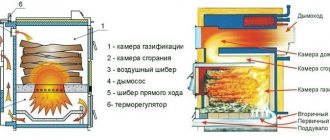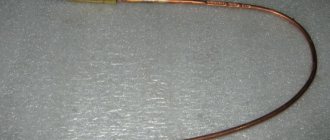Stoves in the house have not lost their relevance to this day; they successfully solve the problem of heating a home. If the house is too large, then using only one furnace device it is difficult to achieve a comfortable temperature in all rooms. In such cases, it is impossible to do without installing an effective heat exchanger and multiple radiators. The coolant is usually water or steam. As a result, the air, walls and floor are heated evenly throughout the building, creating a microclimate quite comfortable for people.
High efficiency of steam heating is possible only if high-quality equipment that meets all standards and requirements is used for its installation. Source plasportal.com
Principle of operation
When installing steam heating in a dacha, a stove or boiler is used as a heat source. With their help, water is heated to boiling point, then the evaporation process begins. The steam penetrates the batteries through the pipeline, gives off heat, and gradually condenses. The resulting water flows into the heat exchanger through the return pipe.
Steam boiler
When choosing a water heater, it is extremely important to pay attention to the performance of the unit. The larger the area of the heated premises, the more powerful the heating device should be.
In houses with steam heating, a solid fuel boiler is often used. A modern gas heat generator is comparatively more efficient. Using an electric device to heat a home is not economically profitable, which is associated with high costs for electricity.
Household steam boilers are used as a heat source for heating a house: they heat a container of water and drive the resulting steam into heating pipes Source eurosantehnik.ru
Bake
If the house has a stove, it can serve as a heat source when installing steam heating. This will save you from additional waste on dismantling the device and repairing the premises. It’s also worth remembering: coal and firewood are inexpensive fuels. When using it, there is no dependence on centralized electricity and gas supplies.
The steam generator is a heat exchanger; you can make it yourself or order it. The design itself is quite simple, consisting of interconnected metal pipes.
If you plan to use a wood stove as a heat source, you should immediately calculate and design a special heat exchanger Source 1-teplodom.ru
We build a coil from iron sheets
The metal layer must be at least 5 mm for this element. When collecting, a 60*40 mm profile and 5 mm pipes are also used; they are designed to remove water and water mass. The overall size of the device depends on the length of the fuel part of the stove.
The metal layer must be at least 5 mm for this element
If the element is ultimately installed in the heating and cooking system, then the optimal solution would be to ensure that the gas warms the coil shelf and goes into the smoke channels, which will be located in front of the exchanger. With this calculation, it is easy to place a surface for cooking.
The part can also be made in the form of a book if you connect the outer panels with tubes or a profile. But with such a structure, the top shelf will be missing. And for optimal cross-country ability you need to place connecting tubes in the upper part. It is better to organize the inlet and outlet behind the heat exchanger or on its side.
Advantages and disadvantages
Equipped steam heating at the dacha has the following advantages:
- provides intensive heating of rooms;
- steam instantly reaches all areas of the heating system, regardless of its complexity or the size of the building;
- pipes never freeze;
- does not require large expenses for the device;
- can be used in buildings for seasonal residence, for heating several floors;
- maximum heat transfer coefficient;
- Can be used together with heated floors.
Flaws:
- circulating along the circuit, steam creates a lot of noise;
- pipes and batteries can heat up above 100°C, which creates a risk of burns upon contact;
- it is difficult to regulate the indoor air temperature;
- the system is susceptible to corrosion, so it does not last very long;
- in the event of a pipeline breakthrough, a dangerous emergency situation is created (the coolant temperature reaches high values).
Important! Steam heating can be used to heat a house with several floors. The steam rises independently to any height, cools, and returns as condensate. Moreover, the installation of expensive pumps is not required at all.
Do-it-yourself heating installation from polypropylene pipes
Polypropylene pipes are connected using threaded or non-threaded fittings. Threaded fittings come in both detachable and non-detachable types.
When installing heating from polypropylene pipes, you must be guided by the following technical conditions:
- polypropylene pipes must be laid away from open sources of fire;
- if there is a need to install a tank or water meter, it is better to use threaded and detachable fittings. One-piece fittings are used only in conjunction with flexible hoses;
- The use of dirty and deformed fittings, as well as independent thread cutting, is not allowed;
- in the case of joining straight sections or connecting polypropylene pipes of different diameters, you need to use couplings;
- in order not to bend the polypropylene pipe at the turning points, during installation you need to use a special square;
- tees are used at branching points.
Having familiarized yourself with the mandatory conditions for the work, you can begin the installation process.
Heating wiring
As we said earlier, for ease of operation, saving time and money, as well as to achieve maximum efficiency of the assembled system, the project must indicate the location of the following elements:
- corners;
- couplings;
- heating equipment;
- fasteners.
The pipeline approaches the batteries from the bottom or side, and is made according to a single- or double-pipe scheme.
Radiator installation
Before connecting the polypropylene pipe to the battery, the battery must first be assembled, equipped with the necessary adjustment elements, and secured to the wall.
The heating radiator is installed as follows:
- We mark the places where the batteries will be installed. According to SNiP, there should be a gap of at least 2 cm between the heating radiator and the wall, and the distance from the radiator to the floor should be 10-15 cm.
- We install brackets for hanging the heating radiator. To do this, you will need a level so that the radiator hangs level, and dowel nails to attach the brackets to the wall.
- Next, the heating radiator is installed on the brackets.
According to this scheme, all batteries are installed in the room.
Connecting batteries
The procedure for connecting a polypropylene heating pipe to a radiator will be as follows:
- We start by attaching the adapter coupling to the radiator. It must be remembered that to connect polypropylene pipes to an aluminum heating radiator, special couplings are used, which differ from those used to connect polypropylene pipes to cast iron radiators.
- We connect a ball valve, radiator valve or control valve to the installed coupling.
- We connect polypropylene pipes to this tap.
- According to the steps described above, the battery output is connected to the heating pipe.
These are the main stages of connecting PP pipes to heating radiators.
Read material on the topic: How to change a heating radiator without errors
Scheme
The heating system operates thanks to natural circulation. Therefore, the heat exchanger must be installed below the level of the radiators. The circulation pump ensures constant operation of the thermal circuit.
There are open and closed steam heating circuits: in the first case, the system is connected to the atmosphere (open), in the second, it is completely isolated from the effects of atmospheric pressure Source s-proms.ru
Steam heating in a house involves the installation of a one- or two-pipe heating system. The optimal choice of the latter depends on the area of the building that is planned to be heated.
Single-pipe
With single-line wiring, radiators are connected in series. The resulting steam passes through a pipeline from one battery to the next. As a result, the first radiator is always the hottest, the last one is almost cold. The single-pipe system is suitable only for small-sized rooms (no more than 80 m²).
Two-pipe
If the house has a huge area, a two-line heating option should be used. A constant supply of hot steam is carried out through the upper pipe. The cooled condensate returns to the heating unit through the lower pipeline. Regardless of the distance from the boiler, all heating batteries heat up evenly.
A single-pipe heating system is more suitable for heating a summer house or a small house; for a spacious cottage or two-story building, it is recommended to use a two-pipe system Source gubernia.media
Calculating the budget
Experts say that such a system costs slightly less than water heating. After familiarizing yourself with the pros and cons of heating private houses with steam, you can determine whether it is suitable for your cottage or country home
Please note that the key to an effective steam heating system is a well-designed design. To calculate it, we recommend that you contact competent specialists to protect yourself and your loved ones.
We hope that the information provided in this article will be useful to you, and you will be able to use steam heating, assembled with your own hands.
Materials and equipment
To properly equip steam heating, you need to prepare:
- heat exchanger;
- radiators;
- pipes (preferably galvanized steel, copper);
- pressure reducing valve;
- brackets;
- valves;
- clamps, elbows, fasteners;
- welder;
- hydraulic valve;
- reduction-cooling device;
- pump;
- container for collecting condensed steam.
Advice! To minimize the cost of organizing steam heating, expensive equipment can be rented.
Radiators for steam heating are selected in accordance with the characteristics of the material from which they are made, taking into account the operating temperature Source otoplenieblog.ru
Heat exchanger
When building a brick stove, a heat exchange device will have to be ordered or made on your own. To do this you will need a welding machine and metal pipes. The thickness of the walls of the latter should be more than 2.5 mm. By welding they must be connected in the form of a coil. In addition, it is worth taking care of the tightness of the joints. It is important to take into account that 1 m2 of the surface of a curved spiral produces about 9 kW.
After creating the structure, it is important to check for permeability: fill it with kerosene, then outline the seams with chalk. Darkening of the latter will indicate penetration of a flammable liquid into the heat exchanger. Therefore, it is unacceptable to use such a device for heating with steam.
Self-manufacturing of a heat exchanger is only possible for people who have certain skills, tools and knowledge Source heatylab.com
Installation process
Steam heating in a private house from a stove should be installed in this way:
- When building a stove, place the heat exchanger in the combustion chamber. If the stove device is planned to be used for cooking, there should be no pipes left on top.
- Install radiators and connect the pipeline to them. To ensure natural circulation in the future, it is necessary to maintain a slope (3 mm per 1 m).
- All converters must be equipped with valves designed to remove air.
- For safety reasons, install a shut-off valve in front of each battery or one for the entire system.
- At the beginning of the circuit, install a cooling device, a pressure reducing valve.
- Connect a container to collect condensate. From it, water will flow at an angle back into the heat exchanger. It is not advisable to use a membrane expander: it is not designed for temperatures exceeding 85°C.
- When using forced circulation, install a pump directly in front of the stove (in the return circuit).
Important! Heating systems with natural circulation of steam do not require the installation of a tank or pumping equipment. Therefore, their work does not depend on the presence or absence of electricity.
If heating is planned to be done with solid fuel (for example, wood), then metal pipes must be used to install the system Source 1poteply.ru
Features of low pressure systems
A common version of such a system is closed, using gravity return of condensate to the boiler, which does not completely fill the pipes, and an upper pipe distribution is used.
First, the system is filled with water to the required level, after which heating begins. The condensate flows down a common riser and, when a predetermined level is reached, is forced into the boiler.
In the same system with bottom distribution, it is recommended to install pipes with a slight slope in the direction of steam movement in order to reduce noise effects. At the point where the condensate is drained, a loop-shaped water seal is installed, which prevents the movement of steam onto the condensation line.
The steam velocity in such systems should be moderate, no more than 0.14 m/s. Otherwise, the steam will also capture particles of moisture accumulated on the walls. As a result, the system operates with more noise and increases the risk of water hammer.
Combined wiring, i.e. a combination of upper and lower wiring is used if pipes are laid under the floor of the upper or middle floor of the house. The lumen of the pipes through which water returns to the boiler will in this case be closed by condensate.
If the pressure in the system exceeds 0.02 MPa, it should be made open. The air is removed through a condensate storage tank, and to prevent steam from leaving the system, a condensate drain or water seal is installed. Water from the storage tank is pumped into the heat exchanger, which allows the storage tank to be installed below the level at which the heat exchanger is located.
The coolant for heating a private house with a boiler room is heated in a heat exchanger located in the boiler room. Upon reaching the operating temperature, the steam moves to a manifold that divides the flow into two circuits: for the main rooms and for the boiler room (+)
Useful tips
When selecting equipment for creating a steam heating system, during its installation it is advisable to take into account the following recommendations:
- You cannot use used heating radiators. They are highly likely to have hidden damage, which will subsequently cause the system to depressurize.
- It is not advisable to use cast iron batteries. Under the influence of large temperature changes, they begin to collapse.
- Installation of the circuit must be carried out by workers with certain knowledge and skills. Otherwise, the created design may be ineffective.
- If you install a steam generator in a conventional wood-burning stove, you can significantly save usable space. In addition, home heating costs will be minimal.
- When using natural circulation, it is recommended to install the stove in the basement of the house. This will ensure that condensation quickly drains to the lowest point.
- For safety reasons and to prevent emergency situations, you cannot refuse to install valves.
The installation of steam boilers in a central heating system is prohibited by law. In private homes, this type of autonomous heating can function for decades without requiring replacement of the main structural elements.
The chimney of a stove with a built-in heat exchanger gets dirty faster than a conventional stove, so it needs to be cleaned more often Source roof-tops.ru
Arguments for"
The steam method quickly heats the air in the house.
A wood burning system is a more economical option than gas or electricity.
It is not necessary to demolish the stove, since in addition to the expenditure of effort and time, major repairs may be required.
Due to the absence of mechanisms, any adjustment is carried out manually, which means that the equipment will not break down or malfunction.
This is an option for a dacha or country house, since the presence there is seasonal, and fuel can be stocked up in advance. The heating will not turn off due to bad weather, non-payment of electricity or gas.
Even if the furnace itself is located in a neighboring building, it is possible to install a steam system. The main thing is to take care of thermal insulation.
How to do this is clearly shown in the following video:
How does steam heating differ from water heating?
In a water heating system, the coolant is often water. It moves inside the pipeline and gradually cools there. In the case of steam heating, the liquid being poured evaporates and hot steam moves through the pipes. After cooling, it condenses and then flows through the return pipeline back to the heating unit.
When the coolant is steam, the thermal output of heating devices is significantly higher, rooms heat up three times faster. Such a system starts up quickly even after a long break in use.
Additionally, it is worth noting the lower cost of materials for steam heating devices. This is explained by the use of compact and ergonomic equipment during installation (for example, pipes of relatively small diameter).
Unlike water heating, steam heating gives greater heat transfer and warms up the room three times faster Source pechiexpert.ru
Liquid fuel stove
Liquid fuel stoves are rarely used in Russia. In Europe, on the contrary, they are popular among owners of private houses. Stove heating is characterized by high efficiency: losses during fuel combustion are insignificant.
- Fuel enters the combustion chamber through the nozzle. The vapors spread quickly in the chamber and ignite. A fan burner is provided for this purpose. It heats the fuel and pumps it into the combustion chamber. The ignition transformer supplies the spark.
- A heat exchanger is located on the side wall of the firebox. It is designed in the same way as a radiator, which allows you to increase the heating area. Water supply and condensate lines are connected to it. A separate outlet is made for hot water or steam.
- The thermal chamber is made of durable materials. It has a chimney for exhaust gases. A separate channel is provided for supplying air from the atmosphere.
- The system is fully automated and equipped with software.
The boiler is installed behind the furnace. The heating system line is built from it. The system is most often made double-circuit to provide residents with hot water. A stove with installed steam heating will last more than 50 years. To generate a power of 10 kW you will need 1 kg of diesel fuel per hour. Manufacturers offer liquid fuel stoves that can be converted to use gas.
Brick oven
So, as mentioned above, for a small building it is enough to build one stove, which will be heated with wood or coal.
The stove model must be chosen in such a way that it can not only heat the premises, but also be an assistant in cooking.
To ensure that this heating structure does not cause any inconvenience and is as efficient as possible, you need to choose a suitable location for it. A well-placed stove can easily warm two rooms and a kitchen.
Such a stove will successfully heat several adjacent rooms.
For example, this model shown in the figure would be a good option for heating three rooms. You need to know that the heat transfer from the stove depends on the surface area of the building, i.e. if one side of the stove opens into the room, it will be fully heated. In addition, the massive structure takes much longer to cool down. By heating the building in the evening, you can be sure that it will transfer heat into the room until the morning.
The stove must be laid during the construction of a house, but its foundation must be separated from the general foundation of the building. It is possible to install a brick stove in an already built house, but this will be more difficult, since you will have to raise part of the floor and make a hole in the ceiling and roof to install a chimney.
General diagram of a home stove heating system
This diagram clearly shows the structure of the building, the structure of the foundation, the chimney channels and the passage of the pipe through the floors with all the necessary parameters that must be adhered to.
Conclusion
It is possible to say unequivocally what is better - a stove or a boiler (solid fuel, gas or electric) only in relation to specific operating conditions. Here we can only summarize general points. It is preferable to install stoves in small buildings with irregular occupancy. They quickly warm up the room and do not require supervision after stopping. They can also be used as an additional or backup heating source.
Boilers are more often used in large houses with permanent residence. The water heating system effectively heats two-story buildings and provides good heat distribution over height. And with correctly configured circulation, the temperature in the room does not depend on its distance from the boiler room.
We recorded a video in which we clearly examined a number of important points, in our opinion, in choosing between a stove and a heating boiler. And if you still have questions, you can ask us on the official website or by phone.
Choosing the best option
It will be difficult to install a massive brick stove in an already built house. In this case, water heating is best organized on the basis of a metal potbelly stove, which can be placed on a reinforced wooden floor without pouring the foundation.
However, if it is possible to make the foundation as it should be, then preference should be given to a more reliable brick stove structure.
The water circuit around the house for a wood-burning stove is best made from thick steel pipes and with natural circulation of coolant
Installing a circulation pump and/or accumulator in the heating circuit in question is a waste of money and zero additional benefit. They will only complicate the installation of the system. And if the lights go out, these devices will create problems. Whereas the heating option without them will continue to calmly heat the house if there are problems in the electrical network.
How to do it yourself
If you have plumbing knowledge and skills, as well as confident handling of power tools, you can provide steam heating for your home yourself.
To complete the work you will need:
- pipes for heating mains;
- fittings, adapters, Mayevsky taps;
- heating device;
- steam generator;
- control devices.
Attention! In order for the project to be thoughtful, it is worth writing down ideas for the placement of elements, their types and sizes. This can be done directly on the diagram.
The process consists of several stages. In order to start work correctly, and most importantly, to complete it safely, you should design the structure. This means thinking through every meter of the heating circuit taking into account the high temperatures of the pipes.
Boiler
First, the power of the steam boiler is calculated. For a small house, take a capacity of 25 kW; an area of more than 200 square meters will require 30 .
If the heated area is 300 sq. m and more , then you should choose tanks from 35 kW. The boiler power ratio is on average 1 kW per 10 sq. m , if the ceiling is not higher than 2.7 m.
In addition to power, attention is paid to the possibility of heating water for home use.
Important! The boiler must be tested and have a certificate . This is necessary to reduce the risk of accidents.
Heating scheme
After determining the type of boiler, the design operation schemes are selected:
- two-wire with top wiring (the equipment warms up more evenly, condensate goes into the boiler through a separate pipe installed with a slope);
- single-wire with bottom wiring (the part of the line distant from the tank will be heated with hot water).
The choice of scheme is determined by several factors:
- heated area ;
- boiler installation location;
- number of installed pipes and radiators;
- convenient and safe arrangement of pipes and installation of a heat exchanger.
This is a complex process that will require time and careful analysis of the existing conditions.
Materials for lines and radiators
Conventional pipes that are used to supply water will not work. Consumers are offered the following options:
- steel - can withstand high temperatures, however, they rust over time;
- copper - good thermal conductivity, durability and cost;
- galvanized steel - not subject to corrosion, inexpensive.
The last option is considered optimal.
cast iron are primarily considered . They are durable, resistant to aggressive environments and corrosion. Steel ones with ribs are also suitable - for increased heat transfer.
Photo 1. Cast iron radiator with fins, model Prince 640, heat output - 399 W, .
Control devices
The control block is a necessary element, since hot steam is a poorly controlled element. The reducer regulates the pressure, and when it increases, the valve is activated.
The project should have:
- total length of pipes;
- radiator installation locations;
- pipeline branch points;
- necessary adapters.
This is put on paper, a diagram is drawn taking into account the characteristics of the home. All details and dimensions are written directly on the drawing. With the finished model of the future design, they plan and carry out the purchase of the necessary equipment and tools.
Homemade schemes that are easy to repeat
If we consider in detail the materials on the installation of steam heating, it becomes clear that it is quite possible to make a house warm on your own .
Monotube
The simplest scheme is a series connection of radiators , which are connected to the output and input of the boiler. The steam, gradually cooling, moves from the beginning of the circuit back into the boiler. Part of the mechanism is no longer heated by steam, but by hot water.
Reference! The pipes are placed low , and the temperature in the first and last radiators is equalized by connecting the circulation pump.
Horizontal
This simple design is suitable for a small home . If there are many rooms, you will have to speed up the movement of the coolant with a pump . To turn on radiators variably, they complicate the circuit by integrating bypasses (adapters that exclude some sections).
Vertical version of a single-pipe scheme
Provides heat to a house with two or more floors . For a small home with a heated attic or a warm underground floor, this is a suitable type of circuit. Few materials are required, and the design itself is inexpensive.
For each floor a chain of radiators , the required amount of material is calculated, taking into account jumpers with bypasses (this will help make the temperature in the rooms more even).
Leningradka
This is a complicated previous scheme that provides for maximum equalization of coolant temperature along the entire length of the circuit.
The principle of operation is to distribute the coolant in such a way that part of it moves, bypassing the radiators (using bypasses). To do this, a pipe is laid under them, from which there are branches to the inlet and outlet of the battery. The section between the taps is a jumper that will help control the temperature in the room. The coolant goes directly to the next part of the circuit without cooling down.
What is a stove-boiler for heating a home?
This design is a brick-lined casing with a heat exchanger mounted inside. Water circulates through its channels, which, heated to a high temperature, spreads through the pipeline to the radiators. The stove in the house is often used as the basis for this equipment. To increase the efficiency of the system, an additional circuit is built above its firebox. Thus, heat transfer is carried out simultaneously in two ways
- direct, when the radiation comes from the hot walls of the furnace
- indirect, in which the space is heated by water entering the appliances
You can assemble such a structure yourself, without resorting to professional help.











